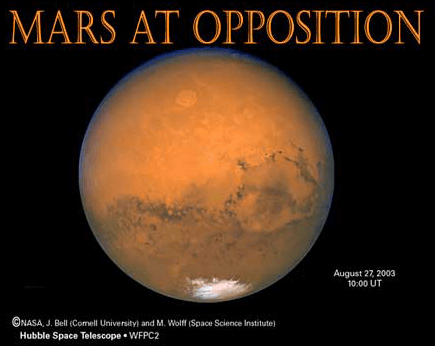Mars Opposition 2022
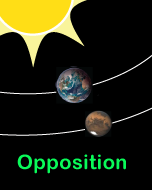
The best time to observe Mars is when it is on the opposite side from the Sun as viewed on Earth as it will be on the night of December 08, 2022. The disk of Mars will be 17.2" and shine at -2.8 magnitude. The planet will be located in the constellation of Taurus. On this night, Earth catches up with Mars again and moves between it and the Sun. Use this link to jump to the night of opposition on this page.
Because of its distance and small size, Mars can be a difficult planet to find in the night sky, because it may appears only as bright as a second magnitude star. Just before opposition Mars becomes very bright and shines all night after the Sun sets. At this time, the two planets will be closest to each other in their orbits. Earth observers can see the full disk of Mars until dawn.
Mars emerges from conjunction in December 2021 but is not readily observed until March of 2022 when the red planet is only 1.5 magnitude and the disk is 4.6" in diameter. But a new apparition has begun and Earth and Mars march toward opposition. This is the 2022-23 apparition of Mars that continues until once again the red planet disappears behind the Sun in November 2023.
Previous Opposition: October 13, 2020 ☆ ☆ ☆ Next Opposition: January 16, 2025
This close approach between Earth and Mars is not unusual, but part of a regular cycle that the two planets established many years ago. Every 780 days, or roughly 2 years and 50 days, planet Earth passes Mars on its orbital track, overtaking the red planet. Opposition occurs when Earth and is directly between the Mars and the Sun. Just before opposition Mars will be very bright and shine all night after the Sun sets and present a full disk until dawn.
The Earth's orbit is very nearly circular, but Mars' orbit is more eccentric, that is, it varies 0.093 from circular. This means the red planet is much closer to the Sun at perihelion (206 million km) than at aphelion (249 million km) a difference of 43 million km. In comparison, the difference between Earth's aphelion and perihelion distance is 5 million km. These distances vary, of course, and I have used extremes. But those differences mean the distance between Earth and Mars at opposition is variable. The count of 780 (actually 778 days) is considered Mars' "synodic" period. Because of the speed of their orbits Earth travels for 2 years, plus an extra 50 days or so when it catches up again with Mars.
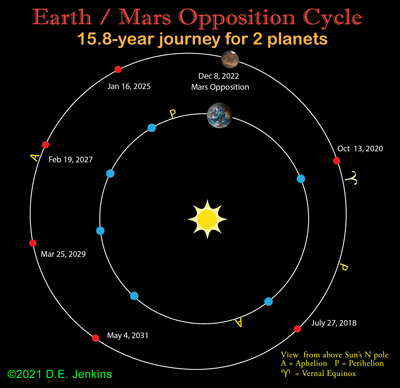
The Earth/Mars opposition cycle can be seen in the diagram. The 2022 opposition is shown at the right, represented by the disks of Earth and Mars. The image shows the solar system as though we are looking down on the Sun's north pole. Although the orbits are shown here with some accuracy, the images of the Sun, Earth, and Mars are not drawn to scale. Both Earth and Mars are shown with the north pole tipped toward the Sun. Other oppositions are represented by blue and red dots. The orbits are both marked with apsides ("a" = "aphelion" and "p" = "perihelion") and the first point of Aries. This marks the 0-degree point for RA in Earth coordinates and therefore helps to orient the orbit. The Earth-Mars opposition cycle repeats for 7 oppositions over a period of 15.8-years. When the cycle has completed 3 times (after 237 or so years) the cycle starts over and the planets again reach opposition at very similar positions where they met in order for 21 times.
In 2022, Mars' declination at opposition will be higher in the northern sky and it will make a better telescopic target for northern observers than it was during the 2020 opposition. This opposition is considered a transitional opposition because Earth will pass Mars when the red planet is in between its perihelion (closest point in orbit to the Sun) and its aphelion (farthest from the Sun). Review the information on Astra's Mars Oppositions page for more information on types of oppositions. Mars is inclined to its orbit with an axial tilt of 25.2 degrees and it points its southern hemisphere toward the Sun during perihelic oppositions. Mars' orbital motion near perihelion is faster than at aphelion so there is a greater distance between perihelic oppositions as compared to the aphelic oppositions. Mars' orbit and axial tilt means that southern summers are shorter and hotter than southern winters. This can be seen in the diagram above. The seasons are not equal: summer in the north lasts 182 days, while southern summers are 160 days. The seasonal differences mean that Mars north polar cap is larger than the southern cap so the southern cap may disappear completely during a perihelic opposition.
December 08 Opposition
The December 08, 2022 opposition of Mars will not be one of the best oppositions because it is a transitional opposition when Mars between aphelion or the farthest point from the Sun and perihelion when Mars is closer to the Sun in its orbit. If Mars is further away from the Sun, it is also further away from Earth when Earth overtakes the slower moving planet.
Mars reaches its perihelion on June 9, long before Earth could catch up to it. Mars will actually reach aphelion on May 30, 2023 long after opposition. Keep in mind that planets move a lot slower when near aphelion. Mars will be closest to the Earth on December 1, that is 7 days earlier than opposition. At that time the distance between the two planets will be .5445 astronomical units (AU) or 50,611,228 miles (81,450,876 km) After opposition, the Earth will speed away from the red planet, only to meet up in January of 2025. For the 2024-2025 opposition Mars will be 9,092,663 miles more distant than it is for this opposition.
Mars rings in 2022 at +1.5 mag. cruising through the stars of the constellation of Ophiuchus sporting a 4" disc. Although it is dim, it may be possible to compare its color with the nearby bright star, Antares. To my eyes the tiny disk of Mars is much more red than the large disk at opposition. At mid-month Venus bursts on to the scene and gives no doubt as to who is the queen of the sky. Mars won't mind however, but continue its path into Sagittarius. From January 25-26th, Mars passes north of the gaseous nebula, M8 (NGC 6523) or the Lagoon nebula. It may be hard to see the nebula in the morning twilight however, although a telescope would help. There is another familiar nebula nearby, called M20 or the Trifid nebula (NGC 6514). Mars passes neatly between these two jewels of the Milky Way galaxy.
Mars can't stop, but continues his journey through what folks in the north know as the "Summer" sky. Mars beats past the lid of the teapot (Sagittarius) only to burst into Capricornus on March 5. In Capricornus, Mars meets up with Venus on March 12th, passing 4 deg. north of the dazzling planet, during daylight hours for North American observers. Compare Mars at +1.5 mag to Venus at -4.6 mag as they put on a show in the early morning sky. Saturn will join Venus and Mars in mid-March, the three planets will form a triangle in the sky, watch as the shape changes daily. On March 28, they are joined by the waning crescent Moon. Venus will move away from the outer planets, leaving Mars to continue closing the gap between it and Saturn until they reach conjunction on April 4 when they come within 0.3 deg. of each other in Earth's morning sky. Of course Mars doesn't have time for such dilly-dallying and soon leaves Saturn far behind, crossing the internationally-recognized constellation boundary and into Aquarius on April 11.
Around April 19, Mars begins to pass the well known asterism in Aquarius, the water jar that is sometimes called the steering wheel. This is where the astrological figure spills out water that creates a "watery" area in the sky. These stars are Gamma, Pi, Eta, and Zeta Aquarii, with Gamma AQR appearing to be surrounded by the others shaped in a triangle. Well we know that Mars can not stop here. In mid-April, Mars will be midway between Venus and Jupiter at their close conjunction (.2 deg. apart!) and Saturn. By May 10, the planets will be well separated, stretching across the morning sky (Venus, Jupiter, Mars, and Saturn.) To see them all, we'll need to get up early in the northern hemisphere as now twilight is short and Mars will be at +.8 mag. Now Mars will approach Jupiter (-2.2 mag), passing .6 deg S. of the gas giant on May 29 in the constellation of Pisces. Around May 11, the apparition begins for those using small telescopes (4 to 8 inches.) At this time the disk of Mars will be 6". On June 3rd, Mercury will join the other planets in the morning sky, probably very hard to see from a northern latitude because of summer twilight. This is best observed from tropical latitudes. Mars reaches its perihelion on June 21 when it is located as close to the Sun as it will get its orbit. Martian winter opens in the northern hemisphere and the southern summer begins. On June 22, Mars will be occulted by the gibbous Moon, visible from a few South Pacific islands.
Mars moves into Aries on July 8. A close conjunction with the Moon occurs on July 21, a lunar occultation visible from Japan, northeastern Russia, northwestern Alaska, Svalbard and north Greenland. The Moon will be just past last quarter. On August 1, Mars catches up with the planet Uranus, passing 1.3 deg. S. of the distant gas giant. Mars will be at +.2 mag while Uranus is a mere +5.8 requiring a telescope to view this event. The two planets will be 13 deg. away from the Pleiades star cluster. Of course, Taurus is the ultimate destination for the red planet that will be at opposition in Taurus on December 8, six months away. Mars crosses into Taurus on August 9th and remains in the constellation for the rest of the year. The red planet will pass below the Pleiades cluster from August 17-19, this should be fun to watch with the naked eye. On August 21, Mars will reach 0.0 mag and rise before midnight. Mars and Earth will reach Western Quadrature when they make a 90-degree angle with the Sun. Earth is the central point of that 90-degree angle.
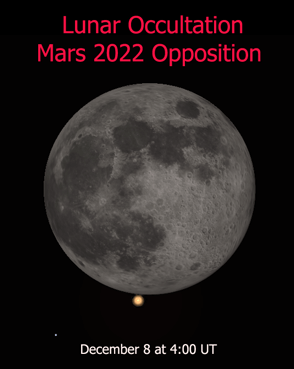
In September, Mars will grow brighter from -0.1 at the beginning of the month to -0.4 at month's end. The disk will grow from 9.8" to 11.9". It will be glowing brighter than the first magnitude star Aldebaran (.85 mag), and pass 4 deg. to the north of it on September 9. Aldebaran and the nearby Hyades clusters will provide an excellent backdrop for Mars. Mars continues its path through Taurus, also it begins to slow noticeably, reaching its stationary point on October 30. Mars will turn around in an area between the horns of Taurus made of the bright stars, El Nath and Tianguan where it spends several days. Although Mars has made a long track through Taurus, the red planet turns and slowly makes its way back, continuing retrograde motion through the end of 2022. At this time, Mars will be 14.9" and shine at -1.19 mag.
On December 1, Mars will be at closest approach when it is as close as it will get to planet Earth. At this time, the disk will be 17.2" and the planet will shine at -1.8 mag. On December 8, 2022, Mars will be at opposition from the Sun as viewed from the Earth. Opposition occurs when the planet is in the middle of the constellation of Taurus. Now the planet will be "up" all night rising as the Sun sets, just like the full Moon. This opposition brings a fantastic opportunity, Mars will be occulted by the full Moon! With the Moon and Mars at opposition within 2 hours of each other, what a great lineup of Earth, the Moon, Mars, and the Sun it will be. This maybe a spectacular event for folks in the north as this occultation will be visible from northwestern Mexico, the continental U.S.A., Canada, Greenland, Svalbard, Europe, western Russia and parts of N. Africa. It occurs at 4UT, so for many preparations should be made for the night of December 7. On December 26, Mars reaches equinox signaling Spring in the northern hemisphere. Mars will be visible for many months after opposition, until it reaches superior conjunction in November 2023. The northern polar cap shrinks as Spring turns into Summer in 2025, so the red planet will be the one to watch for some months after opposition. Next opposition occurs on January 16, 2025.
Astra's first attempt at making a video is a simulation of Mars lunar occultation on December 8, 2022. You may also like the December 2022 is of this What's Up? almanac where this video first appeared.
MARS opens 2023 at -1.2 mag. moving retrograde through the stars of the constellation of Taurus hanging out between the Pleiades and the Hyades, outshining Aldebaran (.85 mag.) The first Mars event of the year comes on January 3 when Mars is occulted by the 12-day old Moon that will be visible from Southern and Eastern Africa, Madagascar, and Maldives. This occultation is the first of 2 occultations this month, 2 more will follow later this year. Mars hits its second stationary point on January 12, resuming its prograde motion. Mars' second occultation will occur on January 31, visible from Polynesia, southern U.S.A., Mexico, Central America, Caribbean, and northern South America. Through the month of January, Mars will lose much of its brilliance, shining at a mere -0.3 mag at month's end. After opposition, observers tend to lose interest but Mars continues its journey.
On February 28, Mars is occulted by the Moon, visible from N. Mongolia, Central and NW Russia, N. Scandinavia, Svalbard, NW Greenland, Iceland, and the Faroe islands. At mid-month Mars passes out of negative magnitudes, and the red planet is shining at .42 magnitude as we move into March. On March 16, Mars will be at eastern quadrature or 90 deg. East of the Sun, shining at .73 mag. Mars passes between the horns of the bull, El Nath and Tianguan (Zeta TAU) the second week of March. It moves into Gemini around March 25. For star color comparison, Mars will make a triangle with Aldebaran and Betelgeuse, two orange or reddish stars. In Gemini, Mars will meet up with Mebsuta or Episolon Geminorum, approaching a mere .15 degrees South. Then Mars will pass below Castor and Pollux, the Alpha and Beta star of Gemini during the month of April. Around May 23rd, Mars and Venus gather with the Moon, Castor, and Pollux. This will be interesting to watch each evening. Tracking them would be a nice project for young astronomers. Even during a single observing session, the motion of the moon and planets may be detected.(Compare positions 15-20 minutes apart for an hour or more.)
Mars pops into Cancer around May 17, shining at 1.48 magnitude. When Mars moves into Leo from Cancer, it will be less than 5 deg. away from Venus, but the two are not destined to meet this time around. On July 9-10, Mars has a close conjunction with Regulus, the Alpha Star of the constellation of Leo. They will be a mere 0.7 deg. away at they closest, not visible from North America, but an interesting event with Venus nearby. Summer twilight as usual will be a problem so be ready at sunset. On August 17, Mars passes into Virgo, shining at 1.8 magnitude, it will be challenging to find it in the evening twilight throughout the end of this apparition of Mars. As the red planet approaches the Sun for Earth-based observers it will brighten up a little bit, but will hug the horizon and be visible during twilight only. An occultation with the thin crescent moon on September 16 at 19 UT might be a daytime observation in North America for dedicated observers. Mars will be too close to the Sun to be observed as it reaches conjunction on November 18, 2023. The next opposition occurs on January 16, 2025.
Stationary and Retrograde Points
Mars and other outer planets appear to change their direction in the sky as the Earth speeds past them. As Mars goes about its normal orbit, it appears to move through the constellations on the ecliptic in a regular pattern from West to East. This is contrary to the motion of the stars that move from East to West as the Earth rotates. So during the months around opposition, Mars becomes bright, calling attention to itself for astronomers or anyone looking up who can see that bright red warrior. The difference between Mars at its farthest distance and when Earth is passing it is greater than it is for any other planets. At first it seems to behave as usual, but then it does a little dance, and starts to move in the opposite direction or retrograde motion.
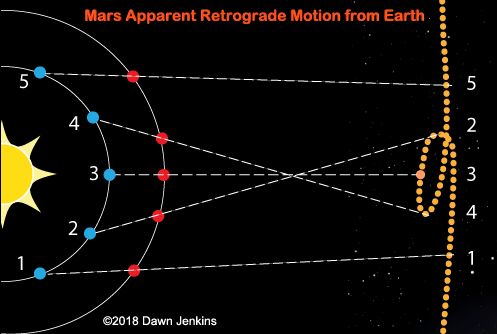
Before retrograde motion begins, Mars seems to stand still. This can be thought of as Earth, coming around the curve of its orbit so that Mars appears to quit moving. This is merely our line-of-sight. It's like being on a train when it is being passed by a faster train. If you are looking out the train window, suddenly you feel like you are moving backwards. Earth and Mars are doing something like this, the blue planet is lapping the red planet on their orbital tracks. On October 30, Mars hits its first stationary point, indicated on the diagram with the number 2. After that it travels in a backward direction (East to West) that is called "retrograde". The night of opposition is December 8 when Mars will shine at -1.8 mag. (position 3) Now the Sun is directly behind the Earth and Mars is 180-degrees away from it. On January 12, 2022 Mars comes to its second stationary point (position 4). Soon Mars resumes its normal course in the sky against the background field of stars that is called "prograde". It's important to remember that Mars never does anything but continue to revolve in its usual counterclockwise orbit. It is only our line-of-sight that makes it seem to move in a loop or sometimes an ess-curve against the background stars.
At position 5, Mars has been left behind and both planets orbit the Sun until their mutual speeds and positions reunite them for the next opposition. The Mars disk shrinks and will continue to do so until Mars disappears behind the Sun in November 2023. The date of conjunction is November 18, 2023 when Mars is 2.5 AU away from Earth.
Mars path through Taurus 2022
During the 2022 apparition, Mars moves through the constellation of Taurus. As viewed from Earth, a loop through the constellation occurs as Mars appears to move backward, that is from East to West. During this apparition the loop is closed, because Mars will appear to cross its own path. Mars begins this journey slightly south of the ecliptic, but crosses the ecliptic in mid-October. The red planet will be above the ecliptic until it returns to the Sun in November 2023.
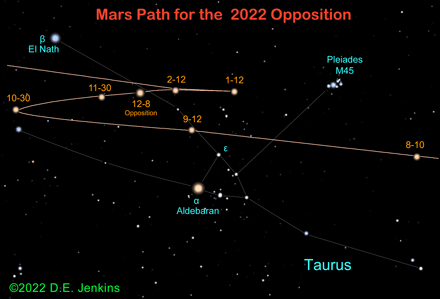
Mars Disk Size
The first disk of Mars on the chart below represents the size and magnitude of the Mars when it first emerged from behind the Sun in 2019. This tiny disk represent the view of Mars when it is far from Earth, presenting a small disk, not quite 4 arc-secs in diameter. As can be seen, the disk will not grow to the grand size it did in 2018, but it will still present a large disk. From the northern hemisphere, astronomers will have a better image of Mars because it will be much higher in the sky.

By December 2022, the disk of Mars will grow to the size noted here for the 2022 opposition. At its closest the actual disk of Mars will be 17.2", or as large as it will be for the opposition of 2022. Because a large disk will give a better resolution, more images will be made by amateurs and professional astronomers alike. Of course, an instrument with a larger aperture will reveal more details on Mars but amateurs with small instruments will be rewarded.
Mars is expected to shine at -1.87 magnitude on the date of opposition, far less than it was during the perihelic oppositions. Its disk will then begin to shrink as Earth pulls away from the red planet. By the beginning of 2025, about 24 days later, the disk will be about 16.0". At that time Mars will be about -1.5 magnitude.
Some helpful links
For more in depth information on Mars at opposition, go to Astra's Mars Oppositions page.
Find out which side of Mars is visible while you are out viewing the red planet through a telescope. Sky & Telescope magazine features an interactive application, Mars profiler. Use this tool to find out what side of the martian surface is currently in your viewfinder or check up on the time of your observation.
A.L.P.O. MARS Section - American League of Planetary Observers
The 2022-2023 Apparition of Mars - by Jeffrey D. Beish
Opposition of Mars - Nakedeyeplanets.com - by Martin J. Powell
Naked Eye planets is a excellent resource for anyone interested in observing Mars or other planets in the solar system. A very detailed description of the path that Mars takes during an opposition is available at the site.
B.A.A. Mars Section - British Astronomical Association
Hubble Space Telescope Images of Mars
Mars in opposition in 2018 (annotated) - Labels features visible shortly before opposition when there was a dust storm
Stormy Mars in opposition in 2018 - About 2 weeks before closest approach
Mars 2016/2018 side-by-side - Show how different Mars looked in 2016 from 2018 due to dust storm and Mars-Earth circumstances
Animation of difference in Mars orientation, 2016 and 2018 - This shows how different seasons on Mars change the planet's appearance for Earth observers. Because the south pole is pointing toward the Sun, Hellas Basin can be seen more clearly during perihelion apparitions.
One last image that I really love because Saturn was at opposition a month earlier than Mars. The year 2018 brought 3 oppositions in quick succession including Jupiter at opposition May 9. This image shows that Hubble Space Telescope is a planetary instrument as well as a deep sky marvel:
For more observation tips go to this article: What's up article/observing Mars.
For drawing help check here: What's up article/drawing Mars.
Last Opposition: October 13, 2020 | Next Opposition: January 16, 2027
To find out about Earth's missions to Mars, go to Astra's Mars Exploration page.
If you love the red planet as much as Astra does, check out the Astra's Stargate main page on Mars, the 3 Faces of Mars page!
